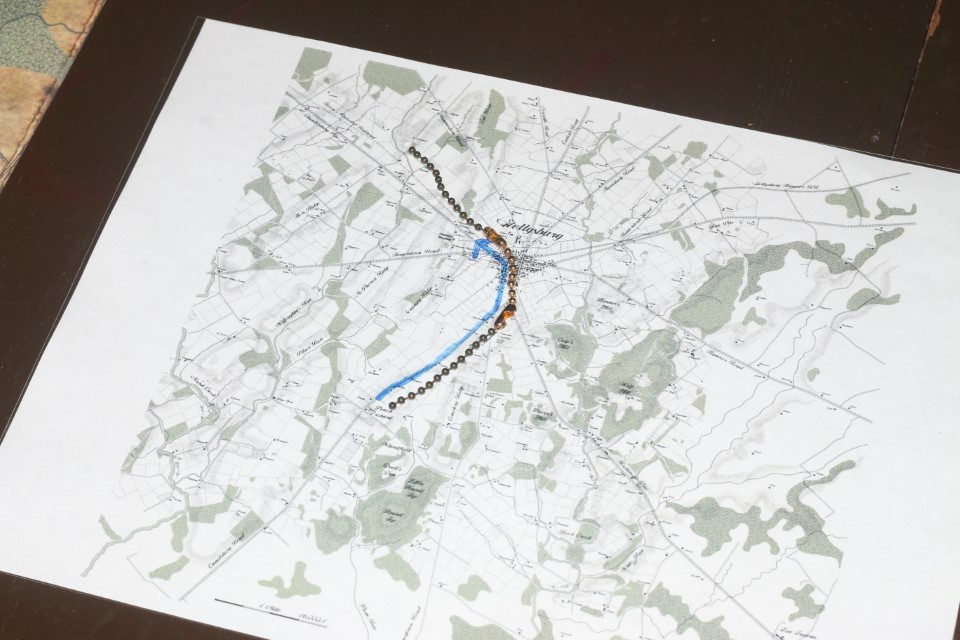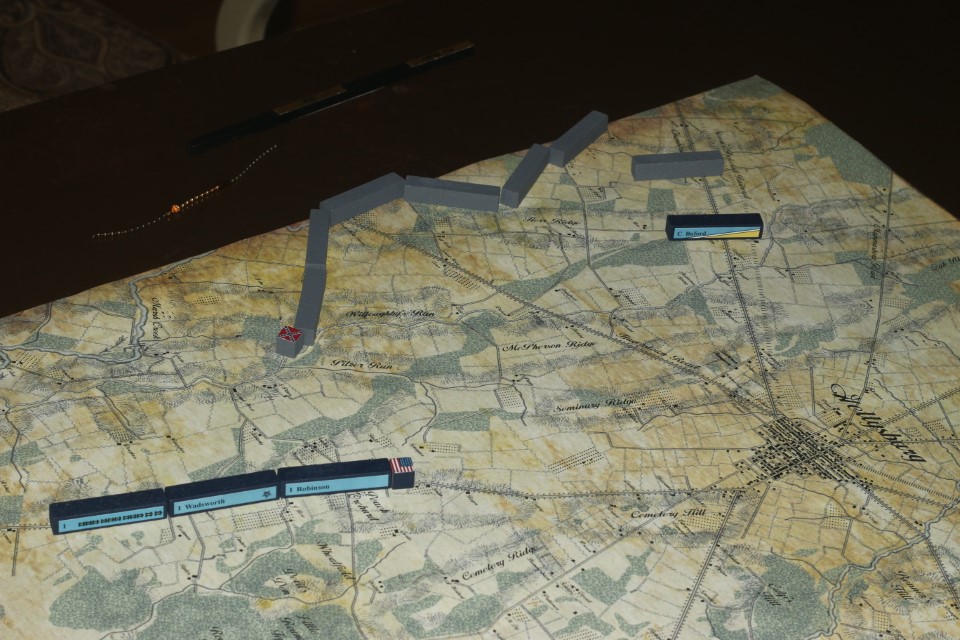We’ve experimented with several different order writing systems for Pub Battles over the years. We love the idea of orders creating C&C limitations / time lag delaying your moves but all our attempts failed when they hit the table. They never seem to create any problems. You can still do all the things you could normally.
Last weekend, we decided to try a new experiment: Graphical Orders. Yeah I know. They didn’t do orders like that back then. True but we figured it was worth a quick test. Maybe we’ll learn something we can use in a modern era game.
Wow, were we surprised! Graphical Orders in Pub Battles are fantastic. Looking back now, it makes more sense. Formal written orders were the norm back then but those were typically issued from the Army to the Corps each night, while maneuvering on campaign. Once the battle was on, there wasn’t much need for that. Everybody is already there! Besides, during a battle, there usually isn’t time for all that. Things are happening too quick.
If you were a Corps Commander in a battle, you wouldn’t write orders to your Divisions. You’d probably just ride up to them in the field and give them quick, verbal orders: “We are going to move forward and form a line facing west along that ridge. See that clump of trees there? Anchor your right on that. Second Division will be on your left. Got it? Good. Go!”
Well guess what? Modern graphical orders turn out to be a great model of exactly that! Think of them as the Corps Commanders showing / telling their Divisions where to deploy in the field.
Now it’s going to take time for them to execute that right? Well, that’s the time from the beginning of the turn to when they actually move. In Pub Battles, a lot can happen during that time! There’s your delay. You have to plan ahead.
How to Use Graphical Orders
We printed a simple conference map on a letter sized page. You can down load a copy for free here. You have our permission to print off extra copies for your own personal use in playing the game.

The Conference Map is exactly 1/3 the scale of the regular map. So you can use the same Pub Battles sticks & Chains on it. A full move on the Orders Sheet is 1/3 of a move on the sticks.
You’re also going to need some clear transparencies from your local office supply store. While you’re there, pick up some fine point dry erase pens.

Example 1
This is turn 2 at Gettysburg, Day 1. Reynolds wants to march up to the Seminary. You draw the ‘order’ like this:

Because he is marching on the road, he can move twice as far. So that is 2 sections on the chains.
The Difference
Ok so the problem is, Hill moves first. Instead of driving on Gettysburg, he makes an unexpected shift to the right and marches south.

In a regular game, Reynolds could just scrap the plan to march north and instead move west to block Hill. Now he can’t! His column has to march as ordered: up to the Seminary:

Now what?!
Example 2
Ok, now let’s back this situation up. Let’s assume for some reason that Reynolds just stopped for Turn 2 and didn’t march.

What happens now for Turn 3? Reynolds wants to get off the road and form a line on Seminary Ridge, directly to the west. You would draw that order like this:

Notice that you are just ordering the Corps as a whole. You don’t go into detail for each block, their exact move, rotation, etc.
Ok now if Reynolds moves first, that is fine. He’ll get up there along that ridge (mostly) before Hill does. If Hill orders to occupy the same position, then Hill will automatically launch an attack to take Seminary Ridge. You have to throw the enemy out, before you can occupy and defend it right?
Same goes for Reynolds. If Hill gets there first, Reynolds must attack uphill to take it!
What can you do as a Corps commander?
You do have discretion over which divisions to put where and when to rally them. It is also up to you to decide how hard to fight during combat. Maybe you were ordered to attack but how hard to you push? Do you attack with only Fresh units? Do you add support? Do you fall back after 1 round of fighting to minimize casualties? Or do you keep pushing with Spent units in additional rounds, with an all-out effort to take the ground no matter what? This is left up to the Corps commanders to decide as it unfolds; NOT put in the orders.
If you don’t hold the ground, you are expected to advance and attack to take it. If you do hold the ground, you must defend it. If you are repulsed back, you must counterattack to get it back.
You are not allowed to move to another location without orders.
Note that the orders define a line that you are to hold and also the direction that your Corps faces.
Example 3
Alright now instead, let’s say Reynolds decides to just play it safe. He doesn’t want to risk losing troops in an uphill assault against the enemy. Instead, he decides to form his defense along the ridge in the Peach Orchard. He draws his orders thus:

Nice, except that these are Hill’s orders:

So the turn ends up like this:

Hill’s Objective is Devil’s Den and Little Round Top. -but Reynolds doesn’t know that yet.
Let’s say Hill moved first here. In a regular game, Reynolds could just move south to cover Devil’s Den and the Tops. Now he can’t. Those aren’t his orders! He MUST move into Peach Orchard, facing west as shown.
Next turn he can issue new orders to shift his Corps south to cover that ground. Fine, but who will move first? If Hill moves first, Reynolds will be having a very bad day.
Example 4
Ewell just attacked on turn 7. There is 1 more turn left of daylight.

On the left, Rodes was flipped and repulsed. There is 1 Federal defender left on Culp’s Hill but they are spent also. One more push might blow them out.
On the right, Early attacked Wadsworth on Cemetery Hill. Half of Early’s men ran. The other half are hanging on to Cemetery Hill but just barely. They are spent, so it won’t take much to throw them back. Wadsworth was repulsed too. Lots of hard fightin! So who won? It depends on what happens next turn. Right now, Cemetery Hill is up for grabs!
So what do you do next turn? Ordinarily, that’s easy. You just sit back and hope you get pulled to move first. If you do, you rush forward, firmly occupy Cemetery Hill and sweep Culp’s Hill clean before nightfall. If you don’t get the first move, roll to jump ahead. If that fails, ok. Just back off and setup camp for the night. You can deal with it tomorrow.
The Difference
Ok but with graphical orders, it’s not so easy. You aren’t sure who will move first next turn but you have to write orders now. If you order an attack but the Feds move first and solidify their line, you still have to attack! The losses could be devastating. Attacking prepared defenders in good terrain with spent divisions could very easily destroy 2/3 of your Corps! Is this attack worth the risk?
This should give you a good feel for how to use these in your games. Try it out and let us know how it goes. Do you like it? Did you see some issues with it? Do you see some ways to make it better?

This really looks great! I do like the inverted spent counters as well. Combined with the chit draw, it gives a unique view of just how things can go very wrong very quickly.
I also think it will make games more dynamic because there will be less pussyfooting around. If the orders say attack, you have to attack. “Ours is not to reason why, ours is but to do or die.” A lot can change from turn to turn. You need simple direct plans. Overly complex won’t work. To much depends on what happens.
Often, when playing Kriegspiel style, I would write full battle orders so that the Corps would never run out of orders. With these orders, the plan will usually make no sense by the second turn, because everything will have changed!
I’ll try and add this too my next video, Austerlitz.
I anticipate future articles on how to graphic certain orders. If you want Corps to secure each others flanks, then that will have to be shown in the orders by drawing the boundaries right next to each other. Likewise, as in your example above, a path will have to be specified, especially for attacking units, or the blocks will simply move straight to the objective.
This is getting cooler, the more I think about it!